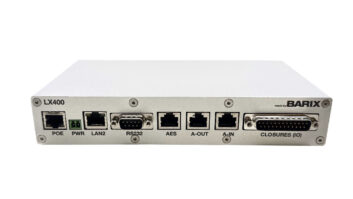Radio World asked several codec suppliers about trends in their area of expertise. Kevin Campbell is WorldCast Systems/APAC Americas APT sales director. This is one in a series.
How have codecs changed?

Kevin Campbell, WorldCast Systems APAC/Americas APT Sales Director. ‘With less emphasis on compression, codec designers will compete increasingly on the core feature set of their devices, on the redundancy they offer and on the interfaces they provide.’
Campbell: The most obvious development in the last few years is the level of maturity in the use of IP links for broadcast. While IP audio has been around for quite some time, it is only in the recent past that it has become an acceptable alternative for the understandably conservative broadcast engineer.
Now it has become relatively simple to install managed IP links for audio transport using MPLS technology and protocols such as QoS and DiffServ. Broadcasters in the major markets are using MPLS in conjunction with a secondary IP link to provide “always-on-redundancy” that can truly rival (or better) the “five nines” offered by T1 services. In the smaller markets, broadcasters are now able to use cost-effective cable modem DSL and microwave links for their STLs and studio-studio links, significantly reducing operational costs. Just a few years back, using these low-grade links meant that the broadcaster would have to accept a significant degradation in audio quality and a raft of reliability issues. Now, the technology exists that means these cost savings no longer have to involve such compromises to service.
Where are they heading?
Campbell: In the context of STL and audio distribution generally, as network speeds increase and bandwidth becomes more readily available, the need for heavy-duty compression is lessening. While rumors of compression’s demise have been circulating for quite some time, it is unlikely to disappear completely. As networks get faster, so the quality of the content gets richer and expands to meet the growing pipe. However, bandwidth is not the precious commodity it once was, and light, gentle compression is increasingly preferred to aggressive psychoacoustic methods.
How reliable is the Internet for mission-critical audio?
Campbell: I think that any engineer worth their salt is right to be hesitant about using the Internet for mission-critical audio transport. It is correct that there are major cost savings to be made and it is now possible to deliver T1 audio quality and reliability over the medium with great success. However, we often forget that the Internet was never designed for real-time communication; it was designed for non-real-time data comms. Therefore the inherent ability of the Internet to offer this is simply not there.
It is up to the codec equipment to implement techniques that allow this to happen, and there are many different techniques on offer. Some techniques will scale back audio quality according to bandwidth availability, some affect delay and others will switch from one link to another causing audio glitches and dropouts. I would urge anyone interested in using the Internet for mission-critical transport to seek out a solution that does not require compromises of this sort.
Where are we with bitrates and algorithms these days?
Campbell: Ironically, new algorithms are becoming less important within the codec domain. Many of the new acquisition and distribution technologies that have emerged use heavy compression and therefore, in the core of the network, in the studio-transmitter and studio-studio links, it is increasingly important to maintain the integrity of the audio content. While several customers still use MPEG and particularly the AAC variants to connect to existing equipment, those establishing new networks and links typically still use linear audio or Enhanced apt-X to preserve the audio content as much as possible in the heart of their transport network.
What about HD Voice and similar developments?
Campbell: HD Voice is not something we have heard much off to be honest. On the network side, it is cost that is having the biggest impact. The affordability of both managed IP and consumer-grade IP links makes it an increasingly attractive option for audio transport and is leading broadcasters to seek out solutions that enable them to use it in their networks.
What’s the next big challenge?
Campbell: With less emphasis on compression, codec designers will compete increasingly on the core feature set of their devices, on the redundancy they offer and on the interfaces they provide. With the proliferation of IP audio networks, and the ever-increasing workload and remit of broadcast engineers, the challenge facing codec designers is to translate the intricacies of IP networking and make connections simple and quick to establish.
What question do you think a smart buyer of codecs should be asking?
Campbell: A smart buyer should be looking not just at unit price but at the total cost of ownership of their STL combination over the coming years. They should be asking what inbuilt redundancy is in their codec hardware.What customer references can the codec manufacturer provide? What upgrade paths are available should they require more channels in future? How does the codec perform over the open internet? What compromises does the unit require when using open IP? Can they get a demo unit to trial the technology?
What is your company’s newest or most notable product?
Campbell: We have seen incredible interest and uptake of APT’s SureStream technology in the U.S. over the past months. SureStream is a multi-award-winning IP audio technology that essentially enables broadcasters to utilize inexpensive, consumer-grade IP audio links and deliver the audio quality and reliability that you would expect from a T1 link. With no compromise to quality, SureStream can deliver savings so significant that return on investment can be as little as four months. It is currently available on the stereo Horizon NextGen, the multi-channel WorldNet Oslo and our brand-new compact, multi-channel AoIP platform the Oslo 1U.












